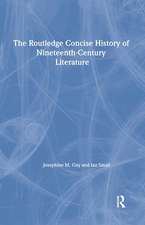Tolstoy's 'What is Art?': Routledge Library Editions: Tolstoy and Dostoevsky
Autor Terry Diffeyen Limba Engleză Hardback – 8 aug 2014
This book, first published in 1985, argues that these are not mere oversights on the part of Tolstoy: he knew full well the consequences of his line of reasoning. The author contends that, even if we disagree with and eventually reject much of what Tolstoy concludes, his account of the nature and purpose of art is nevertheless worth consideration.
Diffey’s argument by no means accepts all of ‘What is Art?’, but by suggesting that the work is best interpreted as a counterpoint to the amoral aestheticism prevalent in Russia at the time, he does much to restore it to a status deserving attention, particularly in today’s climate of extreme relativism.
Preț: 780.08 lei
Preț vechi: 951.31 lei
-18% Nou
Puncte Express: 1170
Preț estimativ în valută:
149.27€ • 162.65$ • 125.78£
149.27€ • 162.65$ • 125.78£
Carte tipărită la comandă
Livrare economică 23 aprilie-07 mai
Preluare comenzi: 021 569.72.76
Specificații
ISBN-13: 9781138780446
ISBN-10: 1138780448
Pagini: 176
Dimensiuni: 156 x 234 x 15 mm
Greutate: 0.39 kg
Ediția:1
Editura: Taylor & Francis
Colecția Routledge
Seria Routledge Library Editions: Tolstoy and Dostoevsky
Locul publicării:Oxford, United Kingdom
ISBN-10: 1138780448
Pagini: 176
Dimensiuni: 156 x 234 x 15 mm
Greutate: 0.39 kg
Ediția:1
Editura: Taylor & Francis
Colecția Routledge
Seria Routledge Library Editions: Tolstoy and Dostoevsky
Locul publicării:Oxford, United Kingdom
Public țintă
Postgraduate and UndergraduateCuprins
Preface. 1. Introduction2. Art as the Expression of Feeling3. Works of Art: Evaluation and Classification4. Counterfeit Art5. Art, Science and Morality6. Tolstoy’s Polemic: A Postscript
Descriere
With its demand that works of art be judged according to the their morally didactic content, Tolstoy’s reviled aesthetics has seemed to exclude from the canon far too many works widely accepted as masterpieces. First published in 1985, this study argues that these are not mere oversights on the part of Tolstoy, and contends that, even if we eventually reject much of what Tolstoy concludes, his account of the nature and purpose of art is nevertheless worth consideration.


























